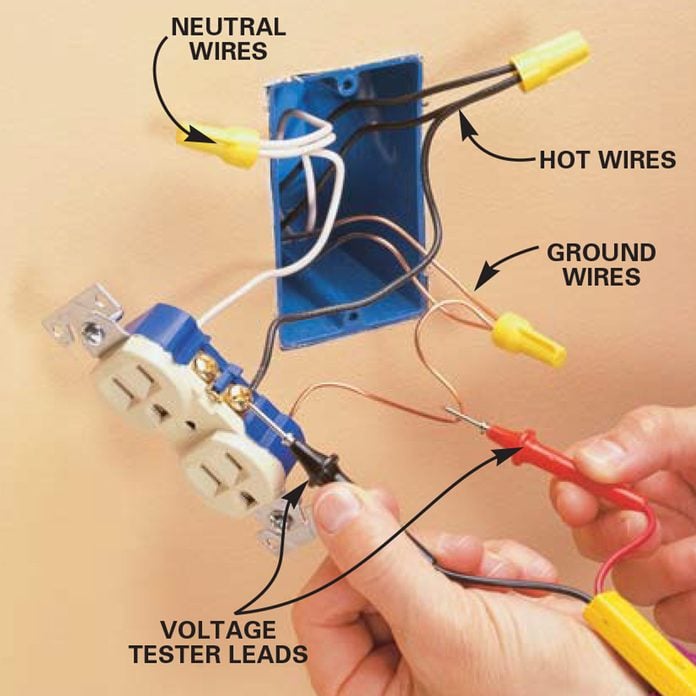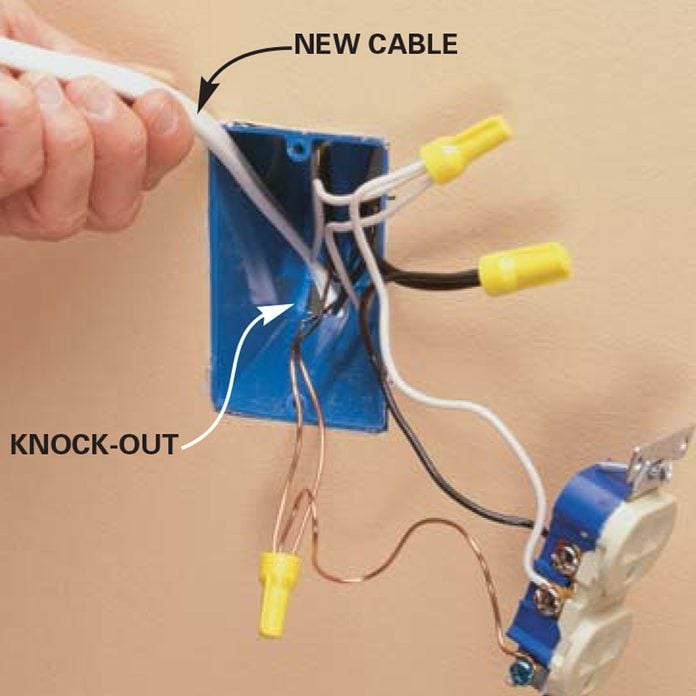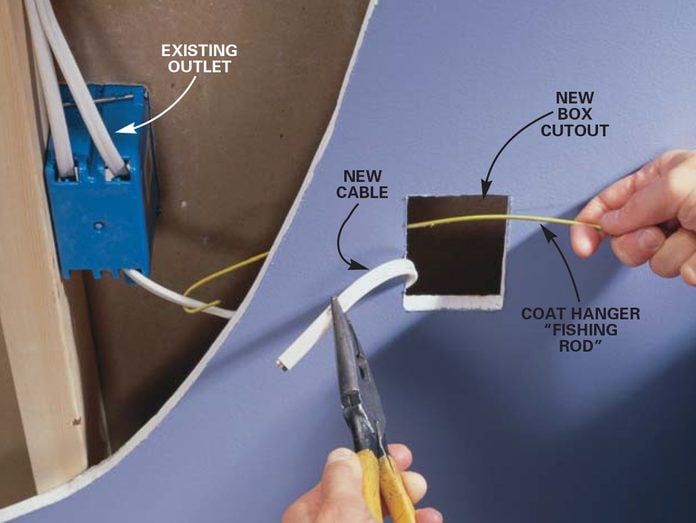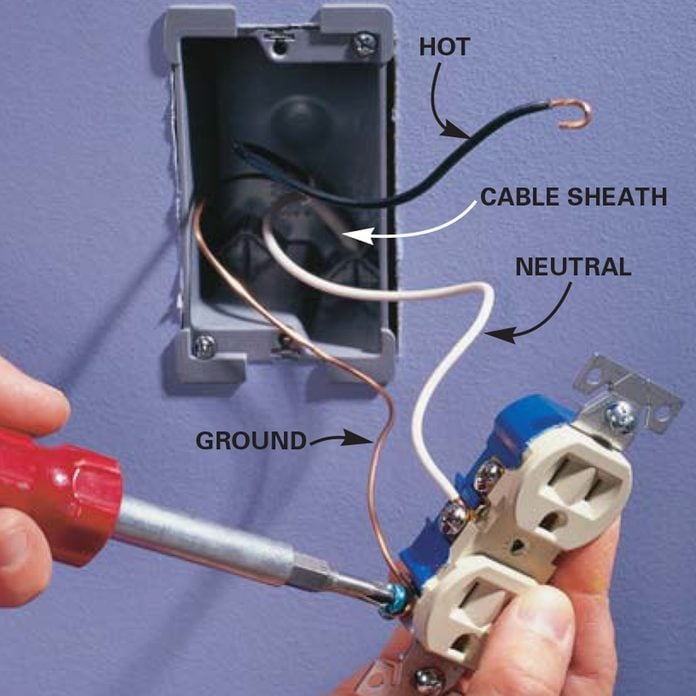How To Install A New Power Outlet
How to Wire an Outlet and Add together an Electrical Outlet
Use this piece of cake method to install a new electric outlet without a lot of wire pulling.
![]() Time
Time
A full day
![]() Complexity
Complexity
Intermediate
![]() Cost
Cost
Less than $20
Introduction
Eliminate those ugly and oftentimes dangerous extension cords. You can add a new outlet rapidly and hands without tearing open a wall, if you already have an electrical outlet in the other side of the wall. No extra holes. No messy patching and repainting. The procedure we evidence here allowed united states to center our Tv against a wall in the family unit room that had no outlet. Since at that place was already an electric outlet in the other side of that same wall (facing into an next chamber), we just added a new outlet in the family room, drawing power from the bedroom outlet.
Tools Required
Materials Required
- Electrical cable
- Receptacle (outlet)
- Remodeling box
- Wire connectors
You'll Need to Find a Ability Source
This technique merely works if you tin utilize an electrical outlet as a power source that's opposite, or near opposite, the identify where you want your new wall outlet. To determine how to wire an outlet and whether you lot can safely use existing electrical outlets, follow the list below.
You lot Can Use Another Electric Outlet When:
- If a switch or outlet is on a circuit that ofttimes blows its billow or fuse. (Don't make matters worse by adding yet another outlet to the excursion.)
- Electric codes restrict the number of lights or electrical outlets that tin can exist connected to ane circuit. Typically, you can have no more than eight lights or electrical outlets on a 15-amp excursion. To decide the amp rating of a excursion, just look at the number on its billow or fuse in your main electric panel. Turn off the excursion and test light switches and other outlets to make up one's mind exactly which lights or outlets are on a given circuit.
- Most electric codes now crave outlets in kitchens and bathrooms to be on split twenty-amp GFCI circuits. So before using the method we show here for how to wire a wall outlet in a kitchen or bathroom, cheque with an electric inspector. If you add an outlet to a kitchen or bath, it must be GFCI protected. Don't ability your new outlet from a kitchen or bathroom outlet.
- Codes likewise limit the number of wires that can enter an electrical box or electric receptacle, depending on the inside book of the box and the gauge of the wires. The outlet-improver methods we show hither are based on the most common wiring (14-judge wire on a 15-amp excursion) and an 18-cu.-in. box (typical within dimensions are about 2-in. x 3-ane/4 in. ten 3-in. deep). If the circuit is 20-amp — which means thicker, 12-gauge wire — or if the existing box is smaller than 18 cu. in., you tin can't wire a new wall outlet as nosotros evidence here unless you supplant the existing box with a larger one. Plastic box sizes are stamped on the inside at the back.
Always ostend the required box size with your local building inspector. In most regions, you demand an electrical permit for this piece of work from your local edifice department. This helps ensure a condom job. These are the viii nigh mutual national electric code violations.
Watch this video to learn how to install an electrical box in any room in your habitation:
Work Safely
Before you tackle whatever function of this project, turn off the ability to the circuit at the main electric panel by switching off the breaker or removing the fuse.
Earlier touching whatever bare wires or terminals on a switch or outlet, use a voltage tester on all the wires to make certain the power is off. If you accept quondam, cloth-insulated wiring, phone call an electrician to recommend rubber connections. With wiring an outlet like this, there'due south unremarkably no basis wire and it's difficult to tell the hot wire from the neutral, because both are coated with black insulation.
Project footstep-past-step (five)
Step 1
Shut Off the Electrical Outlet
- Turn off the power at the chief panel. Observe the correct breaker and turn it off.
- Once you lot've determined the electrical outlet to utilise as a power source and close it off, use an electronic stud finder to locate the studs on both sides.
- You tin put your new outlet anywhere between these two studs.
- Unscrew the outlet and use a voltage tester to double-cheque that the power is off.
- With either lead touching a basis wire (bare copper), impact the other pb beginning to the neutral terminals (argent colored), then to the hot terminals (gold colored).
- If the low-cal glows with either contact, the circuit is still alive.
- Hold the confront of the new electrical box confronting the wall where you desire it to go, and trace around it with a pencil.
- Cut out the hole with a drywall saw.
- Pro tip: Be certain to buy a "remodeling" box that tin exist secured to the drywall, non one that must be mounted on a stud.
- Side by side, using a screwdriver, unscrew the existing outlet on the other side of the wall outlet from its box and dial out one of the knock-outs at the back of the box.
Here's how to use electrical testers.
Aluminum wiring requires special treatment. If you have aluminum wiring, telephone call in a licensed pro who'due south certified to work with it. This wiring is dull gray, not the dull orange that'southward feature of copper.

Step ii
Feed New Cable into the Wall
- Feed a length of new cable through one of the knock-out holes at the dorsum of the existing box (punch out the hole with a screwdriver).
- Feed through enough cablevision to accomplish the new box plus an actress foot.
- Utilize 14-gauge wire for a fifteen-amp circuit.

Step three
Rewire the Existing Electrical Outlet
- Connect the wires of the new cablevision to the existing wires.
- Strip near 10 inches of plastic sheathing from the new cable to expose the black, white and copper wires.
- Run the new cablevision, with sheathing, at least two inches upward inside the box, and double over the excess wires to assist hold the cable in place.
- Strip v/8-in. of insulation off the ends and connect the wires from the new cablevision to the existing bundles — white to white, black to blackness, ground to ground.
- Use new wire connectors of acceptable size for the four wires in each bundle.

Stride 4
Fish the Cablevision to the New Location
- Mark the opening for the new box and cut it out with a drywall saw.
- Fish for the new cable with a hook made from a wire coat hanger.
- Pull the cable through the opening cutting in the wall.
- Then strip nigh nine inches of sheathing off the finish of the cable. Insert the cablevision then the sheath extends about one inch into the box and mount the box in the wall.

Stride 5
Wire the New Electrical Outlet
- Mount the new box in the opening.
- Connect the new wires to the new outlet: white (neutral) wire to a silver-colored last spiral; black (hot) wire to a golden-colored concluding screw; bare wire to the green grounding screw.
- Make sure the cablevision sheath remains secured inside the box
- Finally, phone call the electrical inspector to bank check your work.

Originally Published: June 17, 2022
Source: https://www.familyhandyman.com/project/add-electrical-outlet/
Posted by: davidsonagainto.blogspot.com


0 Response to "How To Install A New Power Outlet"
Post a Comment